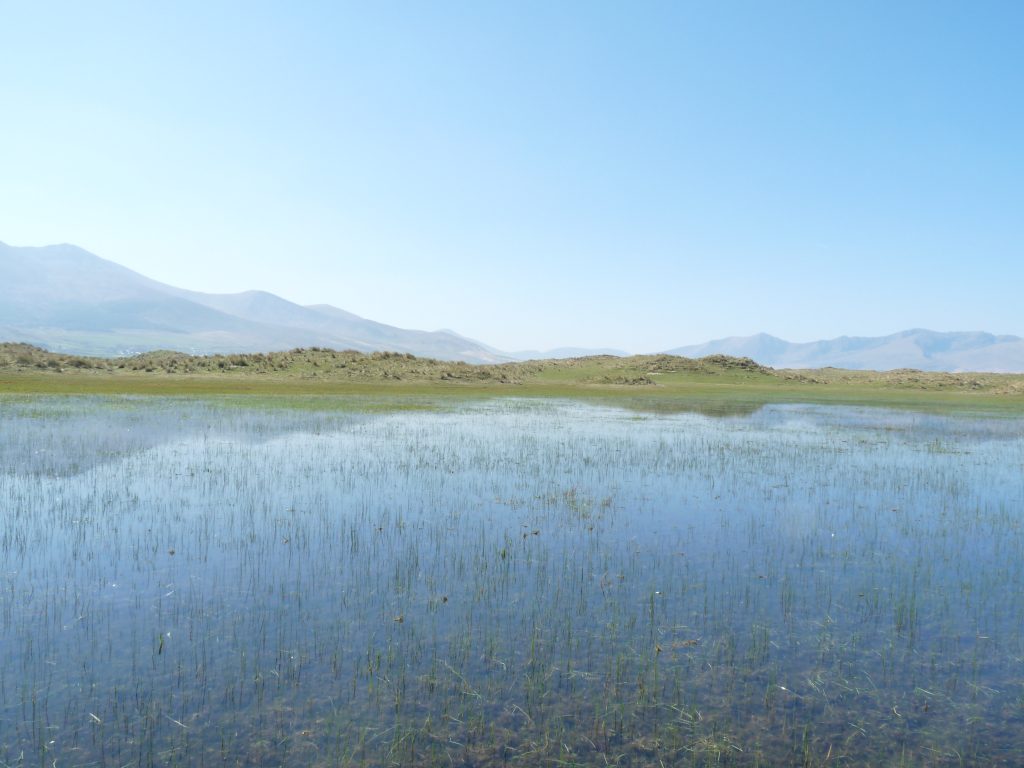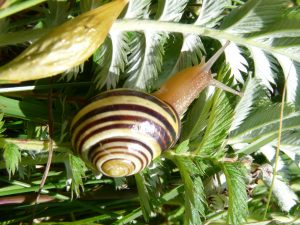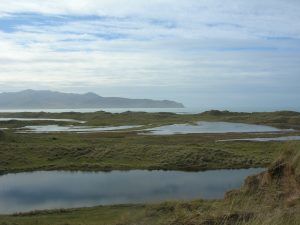

The influences on hydrology and ecology in coastal wetlands

March 30, 2016

Wetlands are places where water is close to the surface and influences chemical and physical processes and biological communities. They provide a different set of resources from other terrestrial habitats, so in arid regions in particular, they support plants and animals which would otherwise be absent from the landscape.
In north-west Europe, sand dunes are as close to an arid environment as you are likely to encounter. Between the dune ridges there are valleys or slacks, some of which are so deep that the water table is always close to the surface and they flood for months in winter. These ponds are isolated from other surface water, essentially acting like wet islands of habitat. In summer, when the ponds dry out, the flora and fauna have to be able to tolerate the dry conditions or escape. This strong influence along with the calcium rich substrate and nutrient poor water has led to dune slacks having a very characteristic plant community. Invertebrates are vital to the functioning of wetlands, breaking down detritus, processing nutrients and providing a food source for other animals, but we know very little about what invertebrates are using dune slacks.
Dune slacks are protected under the EU Habitats Directive and their condition must be monitored every six years. Plant species are used as indicators of general habitat condition, but if plants respond differently from invertebrates to changes in the environment, this could mean that threats to invertebrates are ignored. Water availability and quality have been shown to be key environmental factors determining the plants and animals which use wetlands. In this project, I want to find out what environmental factors affect the hydrology of dune slacks and how environmental factors including water affect diversity of plants and invertebrates in dune slacks.
The study sites were located in County Donegal in the far north west of Ireland, where sand dunes are well developed and potentially confounding factors such as atmospheric nitrogen deposition and water abstraction for domestic use have a relatively low impact. Three dune slacks managed as pasture and three ungrazed sites located in rough area on golf courses were selected. All of the pasture sites were within SACs and enjoy some legal protections. Water abstractions and the use of inorganic pesticides and fertilisers are discouraged. The vegetation is shorter and more disturbed than in the golf courses and there is some direct input of organic nutrients from livestock. In the golf courses, the dune slacks had tall, dense vegetation and water is abstracted for irrigation and use in clubhouses. Inorganic fertilisers and pesticides sprayed on greens and fairways may penetrate to the water table.
At each site, two piezometers were inserted into the dune slacks to a depth of 3 meters below the surface using a Cobra TT percussion drill. Water samples were taken from the groundwater and surface water when it was present in October 2014, January, March and June 2015 and tested for a range of nutrients, alkalinity and major anions and cations. Water levels in the wells were monitored for the period of a year using divers which recorded the water level once every 15 minutes.
Vascular plants and bryophytes were surveyed at each site and snails and water beetles were chosen as the target invertebrate groups. Snails and waterbeetles were chosen because they are both sensitive to environmental degradation, can be identified to species with a strong degree of certainty and they have contrasting biological traits such as degree of mobility and feeding habits.
My preliminary results indicate that values for salt content, pH, alkalinity seem to be well within the range reported elsewhere, with the exception of one site where one of the wells showed signs of seawater intrusion. Nitrogen content is at the lower end of the range for groundwater reported in literature. One of the sites failed to flood for the entire year, and this is likely to be related to the abstraction activities of the golf course management where the site is located. The highest recorded water level was 1.68m. Water generally rose above the ground surface in late October or early November, and they remained flooded the following April at the earliest, although it was not uncommon for surface water to be present in June. At a single site, shallow surface water was still present when it was visited in October 2015. Snails were far more abundant than water beetles and both terrestrial and aquatic species were found. 
I have entered an exciting phase, when the data have been gathered in and are beginning to reveal patterns and processes about the system. The sites are very variable both in terms of their water chemistry and flood period. My next challenge will be to investigate the local processes which may account for the differences I have noted between the sites, in the hopes of explaining at least part of this variation. I will also investigate the diversity of snails and water beetles at my sites, and seek to relate the number or type of species I find to the flood duration and chemical profile of the dune slack water.
For me, relating biological communities to hydrology is the main focus of this work, but the results will help to shed light on other questions. Because sand dunes are made up of a network of Annex I habitats, I can provide insight into the influence of landscape factors on water quality in sensitive environments. Because sand dunes are the last terrestrial landform groundwater travels through, the information I have collected on groundwater quality will contribute to our knowledge of nutrients transport from the land to the sea. But for the moment, I have plenty on my plate, and look forward to drawing together the three strings of landscape, hydrology and ecology over the next nine months.
Aoife Delaney
Trinity College Dublin
You might also be interested in...
Van Walt Guidelines for sampling for PFAS in Groundwater
November 13, 2024We need to make clear, that at the time of writing, there are no ISO or EN standards which deal with the sampling of groundwater for PFAS.
Read MoreSpot measurement v. continuous environmental monitoring
August 25, 2023Environmental monitoring has developed considerably over the years. From the time when a consultant went out monthly or quarterly with a dip tape to monitor the groundwater level in a borehole, wind forward...
Read MoreMeasuring Nitrates (NO3, NO3-N) in the field
June 20, 2023The interest in Nitrates is nothing new. One way or another we have been measuring them for half a century.
Read MoreVan Walt Environmental Equipment
A small selection of our environmental equipment